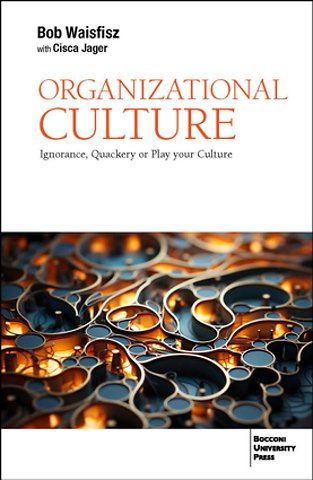

Bob Waisfisz, born in 1942 in The Hague, the Netherlands, is an economist who has worked for the ILO, a UN organization, NGO’s, governments and industry. He spent his childhood in Indonesia and after graduation from the university of Amsterdam, he worked several years in Turkey and Lebanon.
Meer over de auteursOrganizational Culture
Ignorance, Quackery or Play Your Culture
Paperback Engels 2025 1e druk 9791281627420Samenvatting
To measure organizational culture of organizations is an enormous challenge not well understood by most scientists and practitioners. As a result a lot of low-value consulting is sold to clients under the banner of organizational culture.
In these cases nobody knows whether clients receive a description of their organizational culture or whether it is about labor satisfaction or related issues. In this book the reader is told how to separate the wheat from the chaff. The book also provides practical tools for assessing how an organization’ s culture can be aligned with its strategy and how to implement necessary changes in a positive and lighthearted way.
Specificaties
Over Cisca Jager
Inhoudsopgave
U kunt van deze inhoudsopgave een PDF downloaden
1. THE BASICS: Organizational culture, a concept not always well understood
1.1 Introduction
1.2 Definitions of culture
1.2.1 National culture
1.2.2 Organizational cultures in a national context
1.3 Perception of cultural differences
1.4 Other determinant factors of organization culture
1.5 Culture and identity
1.6 Culture and labor satisfaction
1.7 Culture and core values
1.8 Proper use of core values
1.9 Values and virtues
1.10 Individual reality versus group reality
1.11 Management principles versus culture
1.12 The most functional culture is not predetermined
1.12.1 Different objectives
1.12.2 Different strategies
1.12.3 Different environments
1.12.4 Different subcultures
1.12.5 Average assessments and benchmarking
1.13 Different manifestations of culture
1.13.1 Actual culture (measured)
1.13.2 Optimal culture (assessed)
1.13.3 Desired culture (measured)
1.13.4 Culture: “The way we think we are” (assessed)
1.14 Different layers of culture
1.15 The admonition: “Keep it simple”
1.15.1 Managers
1.15.2 The competition
2. HOW TO HANDLE OC SUCCESSFULLY?
2.1 Complexity
2.2 Subjectivity
2.3 One model
2.4 Therefore, the way cultures are measured should be based on rigorous research
2.4.1 Culture and proper scientific research
2.4.2 Hofstede’s research on OC
2.4.3 More considerations
3. CONTENT: A DESCRIPTION OF THE MODEL
3.1 Introduction
3.2 Overview of the model
3.3 Description of the model
3.4 Strategy, the normative question and the model revisited
3.5 Functional diversity
3.6 Typologies or instead combinations of dimensions
3.7 The beauty of the model
3.7.1 Information contained in combining scores on two Dimensions. Inthis case combining dimensions D1 and D2
3.7.2 Information contained in combining scores on three dimensions. In this case combining dimensions D1/ D2 and D3
3.7.3 Two sub-dimensions combined
3.7.4 Reflection on the three diagrams
4. SCAN YOUR CULTURE AND FUNCTIONAL DIVERSIT
4.1 When is it useful or not to have your culture measured
4.2 How to find out whether functional diversity exists?
4.3 How to handle functional diversity?
4.4 Number of respondents
4.5 Attitudes of clients
4.6 Subcultures or the price of functional diversity
5. THE NEW ARCHITECT
5.1 A fragmented supply si
5.2 Culture and proper scientific research
5.3 Basic principles
5.4 An overview of the new architecture
6. DESCRIPTION OF YOUR ROAD MAP
Phase 1, Step 1.1: Prepare
Phase 1, Step 1.2: Fill in three questionnaires
Phase 1, Step 1.3: Choose objectives
Phase 1, Step 1.4: Define degree of importance
Phase 2, Step 2.1: Prepare measurement
Phase 2, Step 2.2: Make it known
Phase 2, Step 2.3: Make it happen; i.e. have your actual culture scanned
Phase 2, Step 2.4: Compare and make your choice
Phase 3, Step 3.1: Prepare your change journey
Phase 3, Step 3.2: Get change content or “Play Jimmy play”
Phase 3, Step 3.3: Get change process; Play your Jimmies
Phase 3, Step 3.4: Change successfully
7. CHANGE MANAGEMENT IN A CHANGING WORLD
7.1 Introduction
7.2 Making change happen should be enjoyable.
7.3 What are causes for such low degree of commitmen
7.4 Cultures and management tools
7.5 Auditors versus management consultants
7.6 Different change processes in different countries
7.7 Sense and non-sense of change management
7.8 Factors having an impact on change
7.9 Willingness to change
7.10 The tell and sell approach
7.11 Clients should be owner
7.12 Integrated change process
7.13 Acknowledge minimum requirements
7.14 Acknowledge the emotional component
7.15 Logistics
7.16 Some more change considerations
7.17 No need for outsiders, but …………………..
8. Capita selecta
8.1 National culture versus organizational culture
8.1.1 Different aspects of reality
8.1.2 Evolution versus change
8.1.3 Non-normative versus normative
8.1.4 One-way indirect causal relationship
8.1.5 One-way direct causal relationship
8.1.6 Applications
8.1.7 Conclusions
8.2 Automation and organizational culture
8.3 Mergers and acquisitions
8.4 Remuneration seen from a cultural perspective
8.5 Global companies
8.6 The police force
ANNEXES
Annex 1: The law of big numbers
Annex 2: The Hofstede Model on national cultures
Annex 3: Additional data collection
Annex 4: Pitfalls; How to assess the competence of potential providers (PP’s)
Annex 5: Scientific article
Vergelijkbare boeken
Anderen die dit boek kochten, kochten ook
Rubrieken
- advisering
- algemeen management
- coaching en trainen
- communicatie en media
- economie
- financieel management
- inkoop en logistiek
- internet en social media
- it-management / ict
- juridisch
- leiderschap
- marketing
- mens en maatschappij
- non-profit
- ondernemen
- organisatiekunde
- personal finance
- personeelsmanagement
- persoonlijke effectiviteit
- projectmanagement
- psychologie
- reclame en verkoop
- strategisch management
- verandermanagement
- werk en loopbaan











